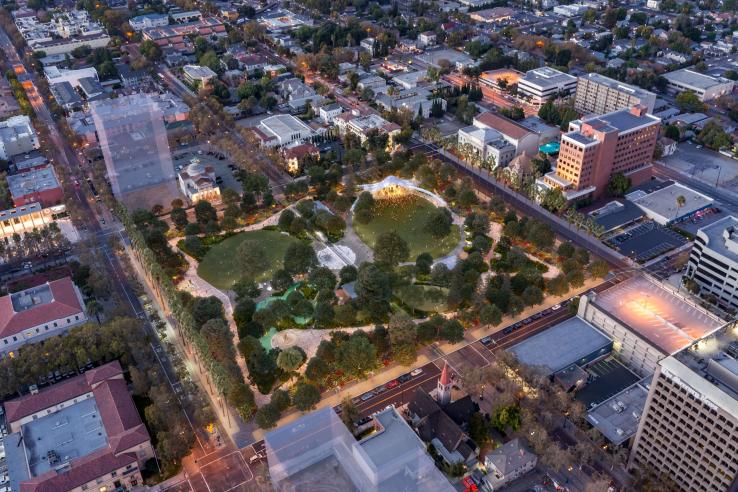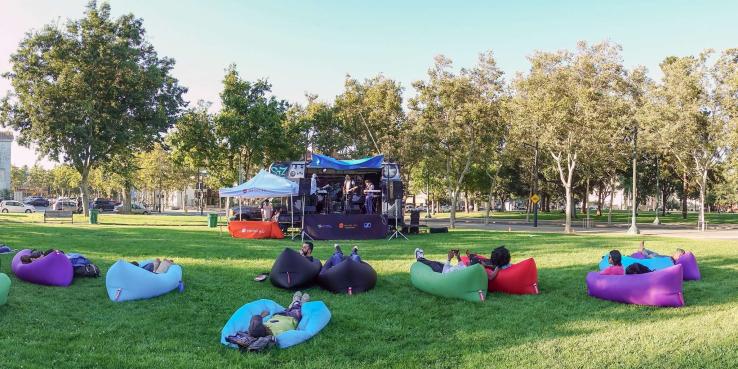St. James Park, at the northern end of downtown San Jose, has long been a center of civic pride for the city. In the late 1800s, its shady paseos and iconic wild gardens made it the destination of choice for city residents to gather. The centerpiece of the district is St James Square, which is included on the National Register of Historic Places. The park has hosted concerts and presidents’ speeches in its time and is surrounded by several of the city’s oldest churches and landmarks, including the main post office, Santa Clara County Courthouse and Sainte Claire Club.
However, the park has lost its place as the premier urban green space of downtown San Jose and lately has battled a reputation for being unsafe and a haven for drug activity. Most recently, it has become a flashpoint in the city’s efforts to manage the park’s growing homeless population, with locals acting in defiance of laws mandating that no food be distributed outside of shelters. In the last few years, attempts by the city and others at activating St. James Park have met with mixed success, and today it is widely regarded as an under-utilized space.
Several new developments have spurred new efforts to bring people back to the park. The Family Justice Center Courthouse, opened in 2016, is just the first of a series of planned high-rise structures in the vicinity. The Marshall Squares property at the southwest corner of the park will bring 190 residential units and almost 9,000 square feet of commercial space by early 2019. A proposed development on the northwest corner would add an additional 226 residential units to what is now vacant land. Within a two-block radius, several towers are already under construction, adding to the growing mix of residential and commercial development in the area.
In 2016, the Department of Parks, Recreation and Neighborhood Services hosted a national design competition to bring a positive public focus back to the park. A jury of city staff, design professionals, and community members selected CMG Landscape Architecture as the winner in November 2016. At a recent SPUR forum in San Jose, Haley Waterson of CMG, Yu-Wen Huang of the city’s Parks, Recreation and Neighborhood Services Department, Mary Rubin of the San Jose Public Art Program and Laura Wolford of the Friends of Levitt Pavilion highlighted the progress made since then.

CMG has spent the last year developing its original concept proposal into an early design plan that establishes the programming and layout of a reimagined St. James Park. Three main elements will provide structure for the park’s design: the historic edge, with its historical connection to the rest of downtown San Jose; the contemporary core, featuring the daily activities of the park’s new programming; and the monument walk, a path that stitches the edge and core together. Other amenities will fit within this framework, including gardens, historic fountains, sculptures, playgrounds and dog parks.
The CMG design also features the Levitt Pavilion, a state-of-the-art bandshell planned for the park’s northeastern corner that would host 50 free, family-friendly concerts a year. Sponsored by the Levitt Foundation, similar pavilions have transformed underutilized public spaces in cities like Los Angeles, Bethlehem, PA, and Memphis, TN, and created communities through music. In San Jose, the Friends of Levitt group has been actively engaged with both the parks project team and the City of San Jose to ensure that the pavilion at St. James Park would be a boon for park activation, creating, as Laura Wolford put it, “a living room for the entire city.”
Despite the compelling vision, a number of issues still need to be addressed. Parks are notoriously difficult to fund even with significant community support. City officials at the forum declined to give an official number, but estimates for the reconstruction of St. James Park are in the range of $40 million. It is unclear how much of this will come from special funding vs. the overall parks budget, which in 2016-2017 was just over $73 million. With the proposed Levitt Pavilion anticipated to constitute 50 percent of the park’s total cost, public support for both the structure and the traffic and noise implications of its programming will need to be strong.
In an attempt to defer some of that cost further into the future, the project team is currently exploring options for phasing in portions of the park over time. At the forum, they presented four sets of options for executing the project’s first phase:
Option 1: One Fell Swoop
The team’s first option for project phasing proposes constructing the entire project all at once, requiring the total closure of St. James Park for approximately two years. According to Yu-Wen Huang, such a move would “exhibit the city’s complete confidence in the future of the park” and the design plan proposed. However, this option would require identifying and securing all the necessary funding in advance.
Options 2 and 2A: Start in the East
The second set of options postpones securing all necessary funds by building and activating only the eastern side of St. James Park at first. Option 2 proposes the construction of only Levitt Pavilion and its accompanying amenities and infrastructure, offering some activation of the park with concerts while the rest of the park remains untouched. Option 2A is slightly more extensive and builds out the entire eastern half of the park, including Levitt Pavilion. This option would require temporarily closing the western half of the park for staging and construction, but it would bring other amenities like dog parks and picnic facilities in addition to the Levitt Pavilion itself.
Options 3 and 3A: Small Amenities First
Option 3 removes the Levitt Pavilion from the first phase of construction and instead focuses on the playgrounds, dog parks, café and the proposed closure of North Second Street. Option 3A further scales back the first phase, removing the café and leaving North Second Street open to vehicles. Both options allow for daily activation to St. James Park without the upfront financial burden of constructing Levitt Pavilion.
Options 4 and 4A: Work in From the Edges
The final set of options propose blocking vehicle traffic on North Second Street while also constructing Levitt Pavilion and the exterior of the park — the historic edge and monument walk — and leaving the interior of the park in its current form. Another alternative, Option 4A, adds in the playground that is planned for the western half of the park. As with prior options, these proposals offer different opportunities to activate St. James Park, and begin stitching together a bifurcated public space — without building all of the planned improvements at once.
Whichever option is selected, decisions on costs and the fate of North Second Street must be made, and soon, as the city is calling for construction to begin in early 2020. The project team will present a recommendation to the city’s Parks and Recreation Commission on June 6, and discussion and suggestions resulting from that meeting will then inform a presentation to the San Jose City Council later in the month. With such a pressing timeline, the next few months will be critical in moving the St. James Park project forward with decisive action in order to create the revitalized, beautiful community space that downtown deserves.
